
Advanced Practice Decision-Making: Patient Selection and Baseline Assessment for Bispecific Therapies
Panelists discuss the evolving role of bispecific antibodies in relapsed/refractory multiple myeloma, emphasizing their value as off-the-shelf options for patients post chimeric antigen receptor T-cell therapy or ineligible for it, and highlighting personalized treatment decisions based on prior therapies, antigen targets, infection risk, and emerging clinical evidence.
Episodes in this series

The treatment of relapsed or refractory multiple myeloma continues to evolve, particularly with the introduction of bispecific antibodies. Patients with relapsed disease have typically experienced remission before progressing again, while refractory patients fail to respond to therapy altogether. These cases are commonly seen in individuals who have undergone multiple prior treatments. Bispecific antibodies have significantly shifted the treatment paradigm by offering effective, off-the-shelf options beyond traditional chemotherapy, enabling patients to live long enough to access newer therapies as they become available.
Bispecifics are often considered for patients who have progressed after chimeric antigen receptor (CAR) T-cell therapy or who are not candidates for it due to clinical or logistical limitations. In rapidly progressing cases, bispecifics provide a timely alternative, allowing for quicker intervention without the delays associated with cell collection and manufacturing. Prior to initiating treatment, baseline assessments such as recent echocardiograms, ECGs, and pro-BNP levels are commonly conducted to monitor for potential complications like cytokine release syndrome, which tends to be milder with bispecifics compared with other therapies.
Choosing between available bispecifics often depends on the patient’s treatment history and current clinical risks. For instance, those who have failed B-cell maturation antigen–targeted CAR T therapy may benefit from agents targeting different antigens like GPRC5D. Infections are also a consideration, as some bispecifics carry a lower infection risk than others. In certain cases, bispecifics may even be used as a bridge to CAR T therapy, helping stabilize the disease while awaiting treatment logistics. As experience grows, clinicians are increasingly tailoring treatment sequences and exploring off-label approaches based on individual patient needs, trial data, and emerging clinical evidence.
Newsletter
Knowledge is power. Don’t miss the most recent breakthroughs in cancer care.


















































































